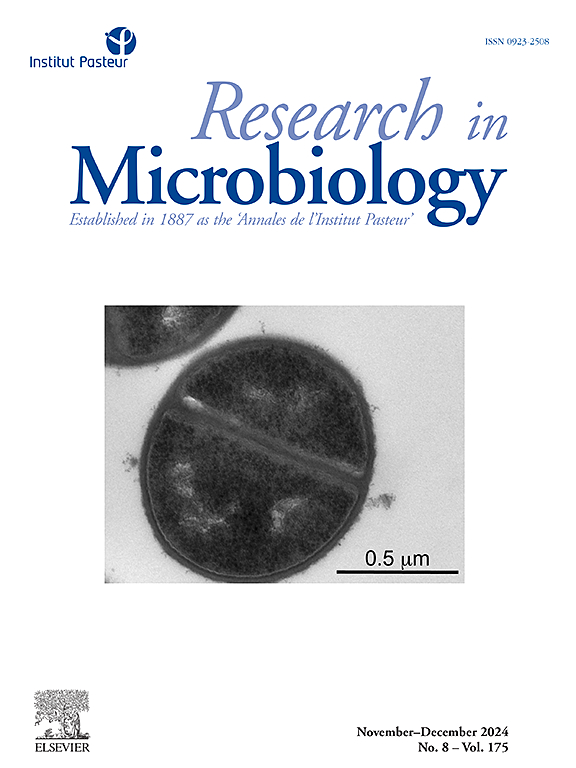Multi-drug resistance and diversity of mobile genetic elements in Escherichia coli isolated from migratory bird in Poyang Lake
IF 3.4
4区 生物学
Q3 MICROBIOLOGY
引用次数: 0
Abstract
With the spread of antibiotic resistance genes such as blaCTX-M-2, dfrA1 and blaNDM-1, the problem of drug resistance in E. coli is becoming increasingly serious [1]. This study aimed to identify integrons genes and MGEs in E. coli isolated from migratory birds' feces at Poyang Lake, Jiangxi Province, focusing on their role in antimicrobial resistance (AMR). The 114 isolated E. coli strains were tested by standard disk diffusion method and genetic testing method. Results showed 64.04 % (73/114) of isolates were multi-drug resistance (MDR), mainly resistant to 3–6 antibiotics. Common resistances included neomycin (50 %) and streptomycin (48.25 %). We detected 21 mobile genetic elements, including IS903 (92.11 %), traA (72.81 %), ISCR3 (64.91 %), and ISpa7 (50 %). These elements were present in all isolates, forming 112 combinations. Significant differences in resistance rates were found between class I integron-positive and negative strains for doxycycline, tetracycline, bacitracin, and streptomycin (P < 0.01), and for neomycin (P < 0.05). Class II integron-positive bacteria showed higher resistance to doxycycline (P < 0.01) and ceftizoxime (P < 0.05). No significant differences were observed for class III integron-positive strains. This study underscores the prevalence of multidrug-resistant and the diversity of mobile genetic elements in E. coli, emphasizing the need for continuous monitoring.
鄱阳湖候鸟大肠杆菌多药耐药及移动基因多样性分析
随着blaCTX-M-2、dfrA1、blaNDM-1等耐药基因的传播,大肠杆菌的耐药问题日益严重。本研究旨在鉴定江西鄱阳湖候鸟粪便中大肠杆菌的整合子基因和MGEs,重点研究它们在抗菌素耐药性(AMR)中的作用。采用标准圆盘扩散法和基因检测法对114株分离的大肠杆菌进行检测。结果显示,64.04%(73/114)的分离株为多药耐药(MDR),主要对3-6种抗生素耐药;常见的耐药包括新霉素(50%)和链霉素(48.25%)。共检测到21个移动遗传元件,包括IS903(92.11%)、traA(72.81%)、ISCR3(64.91%)和ISpa7(50%)。这些元素在所有分离株中均存在,形成112个组合。I类整合子阳性菌株与阴性菌株对强力霉素、四环素、杆菌霉素和链霉素的耐药率差异有统计学意义(P < 0.01),对新霉素的耐药率差异有统计学意义(P < 0.05)。II类整合子阳性菌对强力霉素(P < 0.01)和头孢替昔肟(P < 0.05)有较高的耐药性。III类整合子阳性菌株间无显著差异。本研究强调了大肠杆菌多重耐药的普遍性和可移动遗传元件的多样性,强调了持续监测的必要性。
本文章由计算机程序翻译,如有差异,请以英文原文为准。
求助全文
约1分钟内获得全文
求助全文
来源期刊

Research in microbiology
生物-微生物学
CiteScore
4.10
自引率
3.80%
发文量
54
审稿时长
16 days
期刊介绍:
Research in Microbiology is the direct descendant of the original Pasteur periodical entitled Annales de l''Institut Pasteur, created in 1887 by Emile Duclaux under the patronage of Louis Pasteur. The Editorial Committee included Chamberland, Grancher, Nocard, Roux and Straus, and the first issue began with Louis Pasteur''s "Lettre sur la Rage" which clearly defines the spirit of the journal:"You have informed me, my dear Duclaux, that you intend to start a monthly collection of articles entitled "Annales de l''Institut Pasteur". You will be rendering a service that will be appreciated by the ever increasing number of young scientists who are attracted to microbiological studies. In your Annales, our laboratory research will of course occupy a central position, but the work from outside groups that you intend to publish will be a source of competitive stimulation for all of us."That first volume included 53 articles as well as critical reviews and book reviews. From that time on, the Annales appeared regularly every month, without interruption, even during the two world wars. Although the journal has undergone many changes over the past 100 years (in the title, the format, the language) reflecting the evolution in scientific publishing, it has consistently maintained the Pasteur tradition by publishing original reports on all aspects of microbiology.
 求助内容:
求助内容: 应助结果提醒方式:
应助结果提醒方式:


